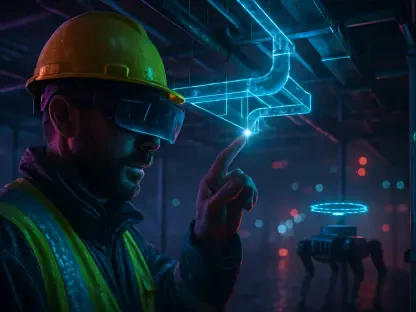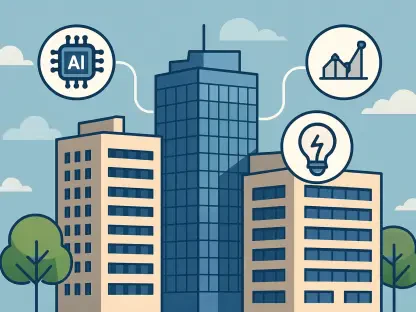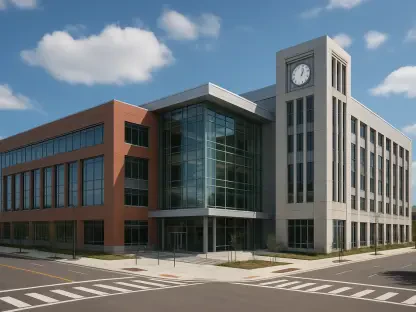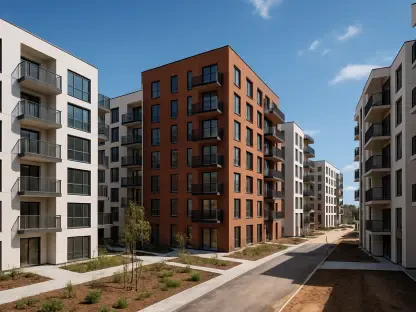The construction industry, responsible for a staggering 40% of global carbon emissions, stands at a critical juncture. Addressing the climate crisis requires urgent action, innovation, and sustainable practices to mitigate its environmental impact. Gillian Charlesworth, CEO of the Building Research Establishment (BRE), emphasizes the necessity of the construction sector adopting net zero emissions targets. She highlights the sector’s potential to lead the way in combating climate change. This article delves into the key elements Charlesworth outlines, offering a comprehensive roadmap for significantly reducing emissions.
Innovative Construction Materials and Methods
Emphasizing Low-Carbon Concrete
The call for more sustainable materials within the construction sector is pivotal. Traditional concrete, a staple in construction, is highly carbon-intensive due to the production process of cement. BRE’s research into low-carbon concrete alternatives shines a light on the potential reductions in carbon footprints. These innovative materials are not only essential in new constructions but also in retrofitting existing buildings, which Charlesworth identifies as a significant challenge and opportunity. Innovating in materials such as low-carbon concrete could transform industry practices, making sustainability a core focus of construction projects worldwide.
Advancing the development of low-carbon concrete requires collaboration across the industry. Manufacturers, builders, and policymakers must work together to create standards and regulations that encourage the adoption of these materials. Charlesworth’s message underscores that the effectiveness of low-carbon concrete is magnified when the entire supply chain prioritizes environmental impact. By pushing boundaries and investing in research, the construction industry can pave the way for greener, more sustainable building practices that significantly lower emissions.
Advanced Insulation Techniques
Another critical aspect of reducing carbon emissions in construction involves improved insulation methods. The significance of developing advanced insulation technologies lies in their ability to enhance a building’s energy efficiency. BRE’s research into high-performance insulation materials and methods demonstrates the importance of reducing energy consumption in homes and commercial properties. High-quality insulation not only mitigates heat loss during winters but also minimizes cooling energy needs in summers. This dual benefit plays an instrumental role in curbing the carbon emissions associated with heating and cooling systems.
Addressing insulation quality in the construction process offers both immediate and long-term benefits. For new builds, incorporating advanced insulation techniques ensures that structures are energy-efficient from the outset. For existing buildings, retrofitting with state-of-the-art insulation materials presents an effective way to drastically reduce energy use. Charlesworth’s insights highlight that making these retrofits a priority can substantially contribute to achieving net zero emissions for the industry by 2050, presenting an actionable solution to one of the construction sector’s pressing issues.
Retrofitting Existing Buildings
The Imperative of Upgrading Structures
Charlesworth identifies retrofitting existing buildings as one of the most significant challenges and opportunities for the construction industry. Given that most of the buildings that will be present in 2050 are already standing, upgrading these structures to meet modern energy standards is essential. Retrofitting involves updating buildings with energy-efficient technologies and materials, significantly reducing their carbon emissions. Charlesworth points out that while retrofitting poses logistical challenges, its successful implementation can lead to considerable improvements in energy efficiency and overall sustainability of the built environment.
The Home Quality Mark (HQM) introduced by BRE becomes a critical tool in this endeavor, offering a standard for assessing the sustainability and performance of residential buildings. HQM-driven retrofitting projects help homeowners and tenants understand the environmental impact of their homes and identify areas for improvement. Adopting such frameworks not only enhances individual building performance but also sets a higher standard for the entire industry, encouraging widespread adoption of retrofit initiatives that contribute toward achieving net zero emissions.
Government Support and Policy Incentives
Achieving widespread retrofitting of existing buildings requires substantial support from governments in the form of policy incentives and funding mechanisms. Charlesworth calls for greater governmental involvement to accelerate retrofitting efforts, emphasizing the need for new policies that incentivize energy-efficient upgrades. Financial incentives, such as tax rebates or subsidies for retrofitting projects, can stimulate investment in sustainable building practices. By integrating retrofit requirements into existing regulations and offering financial support, governments can significantly bolster these efforts, making it feasible for more structures to undergo necessary transformations.
Moreover, public awareness campaigns and educational initiatives are crucial. Raising awareness about the benefits of retrofitting can drive demand from property owners and managers, ensuring that sustainability becomes a fundamental consideration in building maintenance and renovation. Charlesworth advocates for a cohesive approach where governmental support, industry innovation, and public engagement converge, creating a robust framework to tackle the emissions challenge posed by existing buildings. Through this collaborative effort, the path to net zero emissions by 2050 becomes more attainable.
Digital Technology in Sustainable Construction
The Role of Building Information Modeling (BIM)
Digital technology stands as a cornerstone in the pursuit of sustainability within the construction industry. Building Information Modeling (BIM) emerges as a transformative tool that enhances building design precision, reduces material waste, and improves energy performance. BIM enables detailed planning and simulation of construction projects, ensuring that buildings are designed and executed with maximum efficiency. Charlesworth highlights BIM’s capacity to revolutionize how buildings are conceived, constructed, and maintained, offering a vital strategy for the sector to reduce its carbon footprint.
A significant aspect of BIM’s effectiveness lies in its collaborative nature. By sharing comprehensive digital models among architects, engineers, and contractors, it facilitates coordinated efforts to optimize resource use and minimize waste. The precision offered by BIM helps identify potential sustainability issues early in the design phase, allowing for adjustments that can lead to substantial energy savings and emission reductions. Incorporating BIM into standard industry practices is, therefore, essential in driving the construction sector towards net zero emissions, illustrating the power of digital solutions in achieving environmental goals.
Upskilling and Certification
To fully leverage the benefits of digital technology like BIM, there is a compelling need for industry-wide upskilling. Ensuring that professionals across the construction sector are proficient in using these advanced tools is crucial. BRE’s BIM certification scheme plays a pivotal role in this context, certifying the competence of individuals in applying BIM methodologies effectively. Charlesworth underscores the importance of continuous education and training programs that equip the workforce with the necessary skills to adopt and implement digital solutions effectively.
Investing in upskilling not only enhances individual career growth but also strengthens the overall capability of the industry to embrace sustainable practices. As digital technologies continue to evolve, the construction sector must stay ahead by fostering a culture of lifelong learning and innovation. Charlesworth’s message resonates with a forward-thinking approach, emphasizing that a competent, digitally-savvy workforce is indispensable for achieving net zero emissions. By prioritizing upskilling and certification, the construction industry can ensure that it remains at the forefront of technological advancement, driving sustainable transformation.
The Road Ahead for the Construction Industry
The construction industry is at a pivotal moment, responsible for a staggering 40% of global carbon emissions. Tackling the climate crisis necessitates urgent measures, innovative solutions, and sustainable practices to reduce its significant environmental footprint. Gillian Charlesworth, the CEO of the Building Research Establishment (BRE), underscores the critical need for the construction sector to commit to net zero emissions targets. She points out that the industry holds immense potential to spearhead efforts in battling climate change. This article explores the essential elements outlined by Charlesworth, providing a detailed roadmap for vastly reducing emissions. Key strategies include adopting energy-efficient building technologies, integrating renewable energy sources, and implementing sustainable materials. Additionally, addressing the lifecycle impact of buildings—from design and construction to operation and demolition—is vital. By embracing these practices, the construction industry can play a crucial role in achieving global climate goals and securing a more sustainable future.









